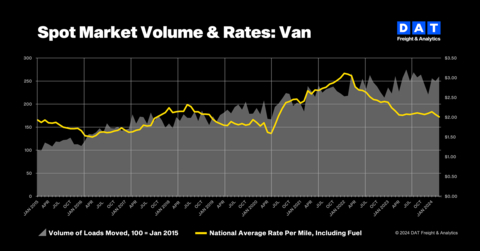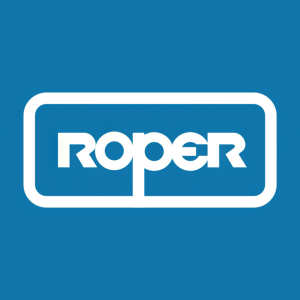DAT Truckload Volume Index: March spot rates drop on modest volumes

(Graphic: DAT Freight & Analytics)
The DAT Truckload Volume Index (TVI), an indicator of loads moved in a month, increased modestly for all three equipment types compared to February:
-
Van TVI: 260, up
4.0% -
Refrigerated TVI: 200, up
2.6% -
Flatbed TVI: 242, up
4.4%
Volumes typically increase from February to March, which had two more shipping days this year. “The decline in van and reefer spot rates coincided with the demand for truckload services picking up marginally toward the end of the month,” said Ken Adamo, Chief of Analytics, DAT Freight & Analytics. “There were no big swings or signs that spot-market volumes or capacity will change beyond what we expect from produce, construction materials, and summer retail goods starting to move.”
Van and reefer rates fell
The national average spot van and reefer rates fell for the third straight month.
-
The van rate averaged
$2.01 6 cents compared to February and15 cents lower year over year. -
The reefer rate fell
8 cents to$2.35 15 cents year over year. -
The flatbed rate rose
1 cent to$2.50 21 cents year over year.
Line-haul rates subtract an amount equal to an average fuel surcharge (
Contract rates made gains
Rates for contracted truckload freight declined for van and reefer freight. The DAT iQ benchmark contract van and reefer rates dipped
The margin between spot and contract rates increased for all three equipment types. It was
About the DAT Truckload Volume Index
The DAT Truckload Volume Index reflects the change in the number of loads with a pickup date during that month. A baseline of 100 equals the number of loads moved in January 2015, as recorded in DAT RateView, a truckload pricing database and analysis tool with rates paid on an average of 3 million loads per month.
DAT benchmark spot rates are derived from invoice data for hauls of 250 miles or more with a pickup date during the month reported. Line-haul rates subtract an amount equal to an average fuel surcharge.
About DAT Freight & Analytics
DAT Freight & Analytics operates the largest truckload freight marketplace in
Founded in 1978, DAT is a business unit of Roper Technologies (Nasdaq: ROP), a constituent of the Nasdaq 100, S&P 500, and Fortune 1000.
View source version on businesswire.com: https://www.businesswire.com/news/home/20240416072308/en/
Annabel Reeves
Corporate Communications, DAT Freight & Analytics
PR@dat.com / 503-501-0143
Stephen Petit
SiefkesPetit Communications
425-443-8976
Source: DAT Freight & Analytics








